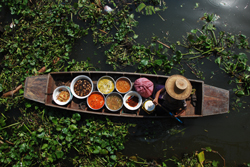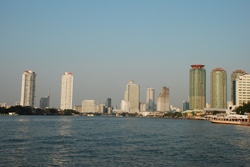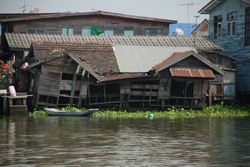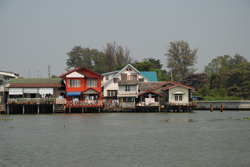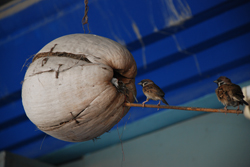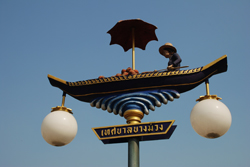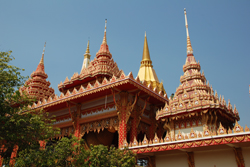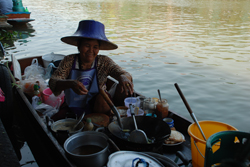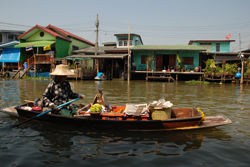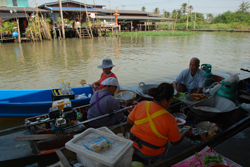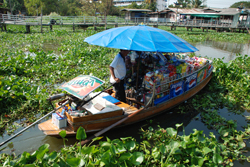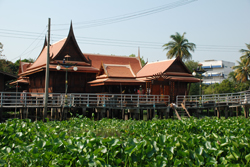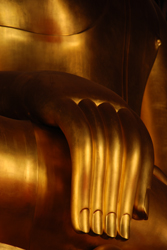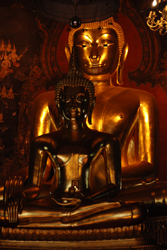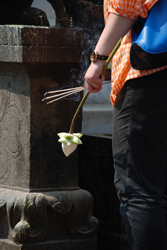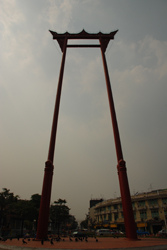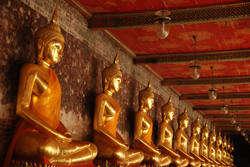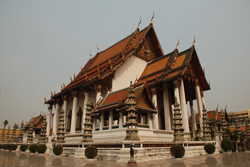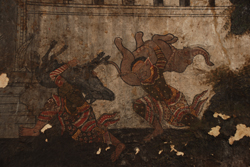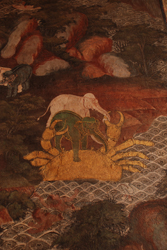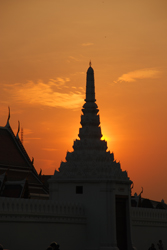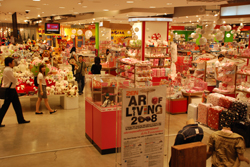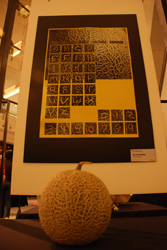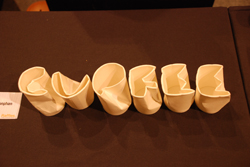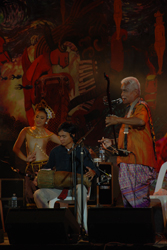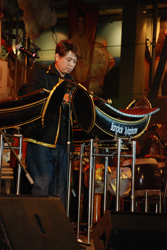Chao Phraya: Searching for the Floating Market
24 January, 2009, 09:12 am in "Thailand"
It is possible to go to Bangkok and not pay much attention to Chao Praya-- the canal which the city is built on. After all-- super highways bring the tourist from airport to the center of the city and skyscrapers and tall modern buildings often hide it from view. However, it is the artery which gave the old city life and still serves as part of the daily life of many people of Bangkok.
We boarded the Chao Phraya Express ferry (13 baht) with the goal of a cheapskate sight seeing tour. Once on the canal, we saw buildings ranging from palaces and wats to the humblest of old wooden shacks on stilts-- some falling into ruin.
It reminded me of a smaller, less wealthy and less trafficked Bosphorus-- it is a living waterway. People sit on piers fishing. There are luxury hotels and houses that have probably been in the same family for ages-- seemingly unconscious of the price of waterfront property but conscious of a precarious existence on stilts above a canal.
We passed a covered docking area housing ornate old barges-- reminiscent of Turkish caiques. I guess the other similarity with Istanbul is in Turkey the Ottomans filled the city with gorgeous mosques and palaces while in Thailand we see the Siamese Royal aesthetic. Both seemed very luxurious and strong patrons of the arts.
The boat moved along quickly (it is a commuter boat after all) and soon we came to the last stop, Nonthaburi. At the station there was a boat tout. His fliers mentioned a floating market at Bang Koo Wieng somewhere on the Om canal. We wanted to visit a floating market but the main one is far and requires an overnight to be there in the morning. The one on the flier seemed like it might be accessible by bus.
We took a boat across the canal in the hope of visiting some of the interesting looking wats we'd seen as we went by. As we were searching for a street leading to the area along the canal we saw some lovely birdhouses made from coconut husks with a stick for a perch added in front. They were suspended by wires from a store front. Sparrows flew in and out or sat on their perches.
We took a boat across the canal in the hope of visiting some of the interesting looking wats we'd seen as we went by. As we were searching for a street leading to the area along the canal we saw some lovely birdhouses made from coconut husks with a stick for a perch added in front. They were suspended by wires from a store front. Sparrows flew in and out or sat on their perches.
Since we couldn't find an easy street to get to the wats, Rowshan asked someone how to get to the Bang Koo Wieng market. Fortunately we had taken a photo of the boat tour flier and were able to point to the photo of the floating market. The people we asked understood this a lot better than other previous attempts at asking how to get to the area with the wats. They told us to catch bus 1002 which was waiting on the street a block from where we were.
It was amazing how different the area became. Though not completely rural, there were areas of marsh, palms, and it seemed worlds away from the shiny cosmopolitan center of Bangkok.
The bus dropped us off at the last stop and the conductor said Bang Ko Wieng was near the bridge. We walked to the bridge which along with the edges of the canal was decorated with street lights each with a boat with seller inside. It looked like it was the intersection of 3 canals (as stated on the brochure) but we didn't see any floating market.
It was amazing how different the area became. Though not completely rural, there were areas of marsh, palms, and it seemed worlds away from the shiny cosmopolitan center of Bangkok.
The bus dropped us off at the last stop and the conductor said Bang Ko Wieng was near the bridge. We walked to the bridge which along with the edges of the canal was decorated with street lights each with a boat with seller inside. It looked like it was the intersection of 3 canals (as stated on the brochure) but we didn't see any floating market.
The area was beautiful. The canals were peaceful with lotuses growing near the edges. Wooden houses lined the river and in the distance, we could see gold spires of a wat. We walked over a bridge and visited Wat Ratprakongthou. It was very new... so new they were still working on it. A huge reclining Buddha rested covered with a protective cloak as a pavilion was being built around him.
We walked back to the canals and decided to eat at a floating restaurant. There was a floating pier with tables and chairs. The cooks all were in little wooden boats around the edges. They served soups, fried rice, phad thai, chicken sate and other dishes. Each boat specialized in a couple dishes.
Occasionally delivery boats would paddle up selling ingredients to the restaurant cooks. Other times a customer would paddle up. Huge fish leapt from the water. The prices were regular street food prices. Our phad thai was 25 baht-- less than $1 and included shrimp. Then we succumbed to an order of 15 banana fritters for 20 baht. These were from small firm bananas fried golden and crunchy with sesame seeds and (I think) honey in the batter. They were the best banana fritters I'd had and we easily consumed the 15.
Next we went to a dock and asked where the floating market is. The people we asked didn't know English and looked blankly when I dug out the word for market “talaad”. Rowshan pulled out the camera and showed the photo. “Ahh talaad NAM!” they exclaimed (nam=water). Then there were some confusing gestures which seemed to say it was here but not here. We thought it just wasn't on Saturdays so we began reading the days of the week. But they shook their heads and answered there was no market on any day.
We gave up, thanked them, and left. Then we saw some tourists and a guide. We asked them. The guide said, “I've worked as a guide for 20 years but there has never been a floating market.”
“You mean the people selling boat tours to the floating market don't actually take you there?” I asked. He said he didn't know.
We contented ourselves with a walk along the canal. There were peaceful wooden houses and we did see a couple women in boats-- one I think, docked by a construction site to sell curries to workers. Others seemed to sell to houses along the canal. We saw a floating mini-mart full of soda bottles and chips.
We gave up, thanked them, and left. Then we saw some tourists and a guide. We asked them. The guide said, “I've worked as a guide for 20 years but there has never been a floating market.”
“You mean the people selling boat tours to the floating market don't actually take you there?” I asked. He said he didn't know.
We contented ourselves with a walk along the canal. There were peaceful wooden houses and we did see a couple women in boats-- one I think, docked by a construction site to sell curries to workers. Others seemed to sell to houses along the canal. We saw a floating mini-mart full of soda bottles and chips.
Even though there was no floating market, we were glad we'd made the trip to the area. It was such an escape from Bangkok. Across the canal was a beautiful teak house. “That must be one of the traditional teak houses,” I told Rowshan.
We returned to the bridge and walked up the other side of the canal. The path ended at the beautiful house. A man and women were leaving. “Are you tourists?” she asked. We replied, “Yes.” She asked, “How did you come here?”
We explained we had been searching for the floating market. She asked us how we liked the area and we responded we liked it a lot. She had just moved here and finished her house but was hoping to rent a room of it out to someone like an expat doing research (who needed a quiet place to read and study).
She told us there was a plan to start a floating market along the canal but right now they had just opened the floating restaurant we'd been to.
We explained we had been searching for the floating market. She asked us how we liked the area and we responded we liked it a lot. She had just moved here and finished her house but was hoping to rent a room of it out to someone like an expat doing research (who needed a quiet place to read and study).
She told us there was a plan to start a floating market along the canal but right now they had just opened the floating restaurant we'd been to.
Bangkok: What a Wat
23 January, 2009, 09:12 am in "Thailand"
We can't blame jet lag so I think I'll blame the warm thickness of the air. The tropical lethargy. The last time I was in Bangkok I thought it was crazy and busy. Now it seems so calm.
Wat Bowan Niwetwihar was the first wat we visited this trip. The building soared upwards with tall columns. The interior walls were dark but covered with scenes of Thai life. Though perhaps they told stories. Little touches of gold added enticing bits of light. The scenes had forests and marine scenes with tall ships.
The paintings struck me as having similarities with American early colonial paintings-- the dark colors, tall ships, buildings with a naïve sense of perspective.
The ceiling was deep red with gold floral star patterns. The central altar portion of the wat was occupied by 2 huge gold Buddhas along with many smaller statues in front. The altar area was decorated with white and pink lotuses and other yellow flowers. The doors were leaf like filigree carvings painted gold with elephants and other figures carved in.Outside people prayed clasping lotus flowers and incense in their hands in front of rows of candles.
It struck me how interesting it is that so many religious figures frown on icons and statues, banning them yet they creep back into the practice-- a human need to have an image to represent their thoughts and prayers.
Next we climbed up Loha Praset across from the Golden Mountain and wandered into the wats in the grounds. The main paintings were floral patterns on dark walls but the shutters had been originally painted black then gold and had the pictures carved into that making a scratch board effect.
Next we climbed up Loha Praset across from the Golden Mountain and wandered into the wats in the grounds. The main paintings were floral patterns on dark walls but the shutters had been originally painted black then gold and had the pictures carved into that making a scratch board effect.
The Giant Swing which is lacking a swing which takes the fun out of it. It was only for ceremonies but I bet it would be pretty cool to swing suspended from the huge wooden structure over the busy traffic filled round-about.
Next to the swing was Wat Suthat. The surrounding covered walkways of the courtyard had more than 100 Buddhas, some black, some gold, and some in the process of being restored (or made). They all had plaques, some with photos so I guess they had been gifts in the memory of people.
In front of the temple were many Chinese stone statues and pagodas as well as bronze horses. However, the building itself was very Thai with gold and green ceramic tiles on the roof and the tall silhouette which seemed to be trying to stretch to even taller heights with the flame-like roof ornaments.
The most amazing aspect was the wall paintings. The black walls were entirely covered with scenes which stretched from the floor to the ceiling about 50 feet above.
The scenes included temples, palaces, wildlife including fantastic dragons (or perhaps just exotic lions). There were people in traditional clothing or ornate palace clothing as well as military uniforms. On one column, an evil looking character carried an elephant. The other wall had rivers, ships, as well as towns and forests.
The scenes included temples, palaces, wildlife including fantastic dragons (or perhaps just exotic lions). There were people in traditional clothing or ornate palace clothing as well as military uniforms. On one column, an evil looking character carried an elephant. The other wall had rivers, ships, as well as towns and forests.
One column had a giant crab carrying off an elephant. A water scene had mermaids and whimsical cat, tiger and mouse fish. The paintings had been restored in 1982-1986 with the participation of Germany.
Though we didn't visit the Royal Palace this trip (since we visited them the last time we were in Bangkok), this did not prevent Rowshan from taking some pretty photos of it.
Bangkok : Design and Modernity
22 January, 2009, 09:12 am in "Thailand"
This morning I awoke to the exotic songs of local birds and the comfortable remnants of cool night air which drifted before being banished by the hot day.
It was a gentle tropical morning even though the sounds of cars and other human generated noises reminded me I was in Bangkok and not a tropical island.
We are staying next to the river. There is a view of a patch of it from the room we've moved into on the 4th floor. Most of the view is obstructed by a luxury apartment building. But the corner room gets a welcome breeze.
Today I willingly went into a department store. I was lured in by a design exhibit on the 8th floor. Yes, an 8 floor department store. We took the escalator up to the 7th floor which required seeing the shopping displays. This was a swank department store. You can tell a swank department store because the sections of clothing are all color coordinated. The in-store DJ was also a clue. There was the American West section with denim blues, browns, and dusty tones, as well as a guitar. The little kids-- mostly pink with some light blue and lavender. Other styled areas: one with black with touches of fuscia, teal, and violet. The Sanrio section (All your Hello Kitty needs but a bit more fashionable than when I was a kid).
It was a gentle tropical morning even though the sounds of cars and other human generated noises reminded me I was in Bangkok and not a tropical island.
We are staying next to the river. There is a view of a patch of it from the room we've moved into on the 4th floor. Most of the view is obstructed by a luxury apartment building. But the corner room gets a welcome breeze.
Today I willingly went into a department store. I was lured in by a design exhibit on the 8th floor. Yes, an 8 floor department store. We took the escalator up to the 7th floor which required seeing the shopping displays. This was a swank department store. You can tell a swank department store because the sections of clothing are all color coordinated. The in-store DJ was also a clue. There was the American West section with denim blues, browns, and dusty tones, as well as a guitar. The little kids-- mostly pink with some light blue and lavender. Other styled areas: one with black with touches of fuscia, teal, and violet. The Sanrio section (All your Hello Kitty needs but a bit more fashionable than when I was a kid).
From the 7th floor we took the elevator to the 8th floor. The design exhibit (Home furnishings) was part sales display but part gallery exhibition. Some furniture pieces were priced and you could try them out (though it was a bit awkward because they were on raised platforms.) Others had “Do not sit” signs. There was a set of furniture of wire frames with colored rubber reminiscent of alien goo from a sci-fi movie. (though not as sticky looking). There were some horribly uncomfortable stools supposedly fitted to how the way people sit has changed. (I can only assume it means people don't sit anymore).
There were also several colorful fun whimsical pieces including sets of 4 animal benches that fit together serving as furniture or play things, some chair covers with quilted animals and things like, “I'm hungry” written on them, and silver plastic versions of these wooden drum stools my family has which as kids we used to play turtle with (holes on the sides and bottom enabled us to stick limbs through). These modern varieties had not considered the turtle game aspect of the design ruining possibilities of this pass time by closing the bottom and making them a bit taller and less turtle shaped.
The shopping mall also had an exhibition from a design school where students had made alphabets using shapes made from or found in particular objects. These were great: some included squished paper cups, sprouts, shoelaces, zippers, forks, and the one I considered most ingenious-- patterns on a canteloupe skin.
There were also several colorful fun whimsical pieces including sets of 4 animal benches that fit together serving as furniture or play things, some chair covers with quilted animals and things like, “I'm hungry” written on them, and silver plastic versions of these wooden drum stools my family has which as kids we used to play turtle with (holes on the sides and bottom enabled us to stick limbs through). These modern varieties had not considered the turtle game aspect of the design ruining possibilities of this pass time by closing the bottom and making them a bit taller and less turtle shaped.
The shopping mall also had an exhibition from a design school where students had made alphabets using shapes made from or found in particular objects. These were great: some included squished paper cups, sprouts, shoelaces, zippers, forks, and the one I considered most ingenious-- patterns on a canteloupe skin.
These 2 exhibits got me thinking that perhaps the Thai design scene is more whimsical than the American scene. It also got me thinking of what design means in regards to the development of a country. What does it mean when a country is able to focus more on “Graphic Design”? What role does the artistic history of a country play?
In Nepal most of the commercial design, for example, signs and public messages, are still rough paintings with unmistakable meanings: a goat or chicken head on a butcher shop. There aren't many sophisticated or abstract concepts (except in religious art).
In Thailand (Bangkok) I was struck, like in Iran, with the abundance of modern graphic design.
I should mention, the reason we were anywhere near the swanky department store and mall was a small world music festival happening in front of it. Some of the acts we saw were drumming, a xylophone group, and a Khmer musician with dancing.
In Nepal most of the commercial design, for example, signs and public messages, are still rough paintings with unmistakable meanings: a goat or chicken head on a butcher shop. There aren't many sophisticated or abstract concepts (except in religious art).
In Thailand (Bangkok) I was struck, like in Iran, with the abundance of modern graphic design.
I should mention, the reason we were anywhere near the swanky department store and mall was a small world music festival happening in front of it. Some of the acts we saw were drumming, a xylophone group, and a Khmer musician with dancing.
Powered by My Blog 1.69. Copyright 2003-2006 FuzzyMonkey.net.
Created by the scripting wizards at FuzzyMonkey.net..
(Code modified by Rowshan Dowlatabadi)
Created by the scripting wizards at FuzzyMonkey.net..
(Code modified by Rowshan Dowlatabadi)


